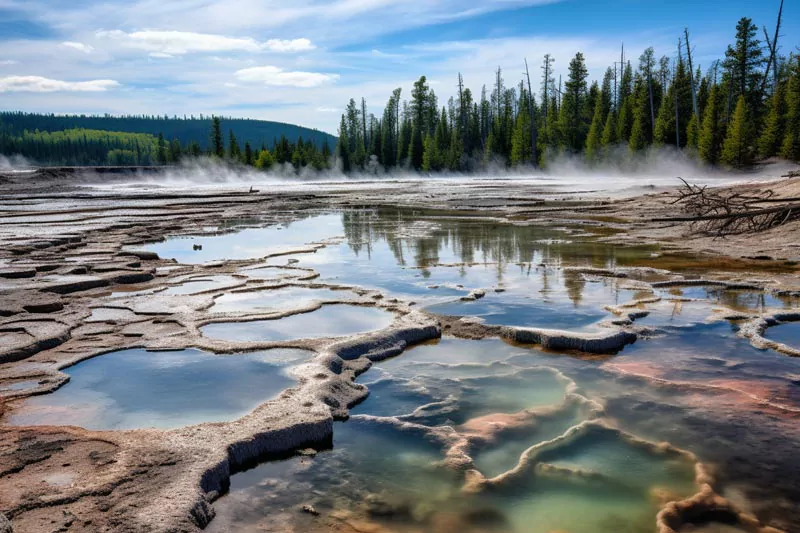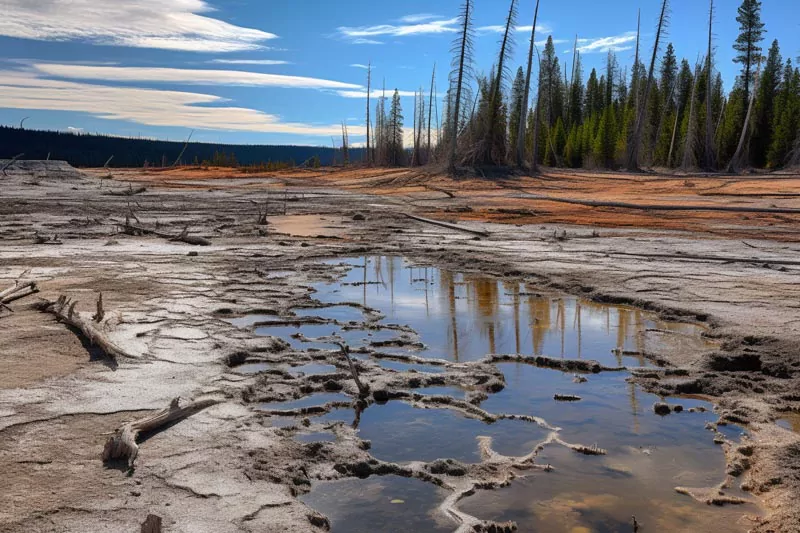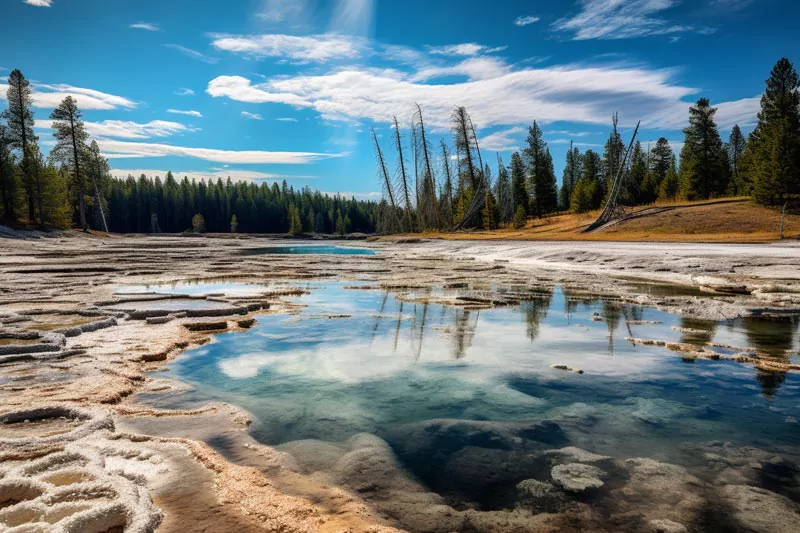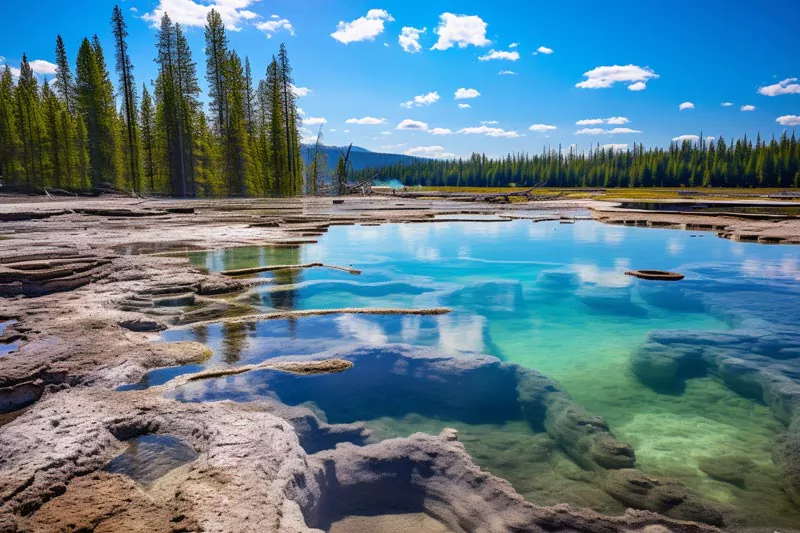
Norris Geyser Basin in Yellowstone National Park: World’s Tallest Active Geyser
The Norris Geyser Basin is the oldest and most active thermal area in Yellowstone National Park where you can feel the power of nature. Here, geysers erupt from deep underground, painting the air with steam. You will be mesmerized by the beauty of nature every time you take a step here.
Two Different Trails of Norris
When starting your trip in Norris, you need to start exploring two trails, the Back Basin Trail and the Porcelain Basin Trail.
Back Basin Trail
The Back Basin Trail takes you through dense forest on a 2.4-kilometer loop. The trail is a treasure trove of thermal activity protected by the National Park Service.


As you walk, you are surrounded by towering trees while being entertained by the sounds of nature – a stark contrast to the noisy geysers in the surrounding area. The path takes you past the lively Echinus Geyser, known for its acidic waters, 60 meters away from Steamboat’s impressive eruptions.
Among the dense green vegetation, you encounter colorful hot springs, a colorful testament to the minerals and creatures that survive in these extreme environments. This is a picture of Yellowstone’s diverse beauty, where the yellow of sulfur blends with the green of the trees.
Porcelain Basin Trail
The Porcelain Basin Road, on the other hand, is only 1.2 kilometers long. With a treeless, lunar landscape, the basin exhibits some of the hottest thermal features in Norris. The trail passes through a world of geysers and hot springs, each a spectacular display of Yellowstone’s thermal power.

This place is home to Ledge Geyser and the mesmerizing Continuous Geyser, with their milky white mineral deposits, cementing the basin’s reputation as the hottest and most variable thermal area in Yellowstone. The noisy geysers in Porcelain have boiling water temperatures reaching 93°C.
Geysers of Norris
Steamboat Geyser
The eruptions of the Steamboat Geyser reach a height of about 90 meters, higher than the Statue of Liberty, offering a breathtaking display of the power of nature.
You are standing close to the geyser, your eyes fixed on the boiling waters, when suddenly a huge column of water and steam rises into the sky. An unpredictable giant, this geyser can sometimes remain dormant for years, but when it awakens, it is a sight to behold.

Echinus Geyser
The Echinus Geyser is another beauty of the basin with its frequent and vibrant eruptions. Named after sea urchins, it reflects its dynamic nature. The hottest geyser in Yellowstone, Echinus has recorded temperatures of up to 237°C. It is rare for the waters at Norris to be particularly acidic. This acidity, combined with iron oxides, creates a surreal landscape around the geyser, reminiscent of an artist’s vibrant palette.
Norris is strategically located at the intersection of two important geologic faults: The Hebgen Lake Fault and another fault running through the basin. This unique location, along with the underlying Yellowstone Caldera, fuels the region’s extraordinary activity. Just north of Norris, the Gibbon River flows toward spectacular Gibbon Falls, and nearby Roaring Mountain reminds visitors of volcanic forces.
Porcelain Basin
The Porcelain Basin is a unique and stunning landscape that resembles the surface of the moon. Named for its milky white minerals, the area offers a clear view of its features, including geysers, hot springs, fumaroles and mineral-rich mud pits. The Blue Geyser is known for its mesmerizing blue water and the Ledge Geyser for its impressive, angled water eruptions.
Back Basin
In contrast, Back Basin has a forested area and hidden features. One of the main attractions, Emerald Spring, is calm-looking but boiling hot and blue-green in color due to the reflection of the sulfur in the pool. The Perpetual Geyser is unpredictable despite its name; when it erupts, it puts on a spectacular show.
Where and How to Get to Norris Geyser Basin?
Norris, the crown jewel of Yellowstone National Park, is located almost equidistant between the park’s North and West entrances.
- If you are coming by car from the North Entrance in Gardiner, Montana, a 34-kilometer drive awaits you.
- For those entering from the West Entrance, in West Yellowstone, Montana, the drive is a little longer, about 45 kilometers, but just as scenic.
Once you arrive in Norris, you will find ample parking spaces. However, a word of advice: During the peak tourist season from June through September, parking can be hard to find, especially during the midday rush. Consider arriving early morning or late afternoon to avoid the crowds and get a stress-free start to your adventure.
FAQs
How much time should you spend exploring Norris’ Thermal?
Time takes on a different meaning at Norris. I recommend at least 1.5 to 2 hours to see the splendor of Back Basin and Porcelain Basin up close.
This time allows you to wander the trails in comfort, immersing yourself in the unique geothermal landscape. For geology enthusiasts and nature lovers, or if you are hoping to see the Steamboat Geyser in action, you may want to extend your visit.
Conclusion
The oldest and most dynamic thermal area in Yellowstone National Park, Norris is a paradise for travelers and nature enthusiasts. This unique area is home to the world’s highest active geysers and mesmerizes visitors with its ever-changing geothermal landscape.







